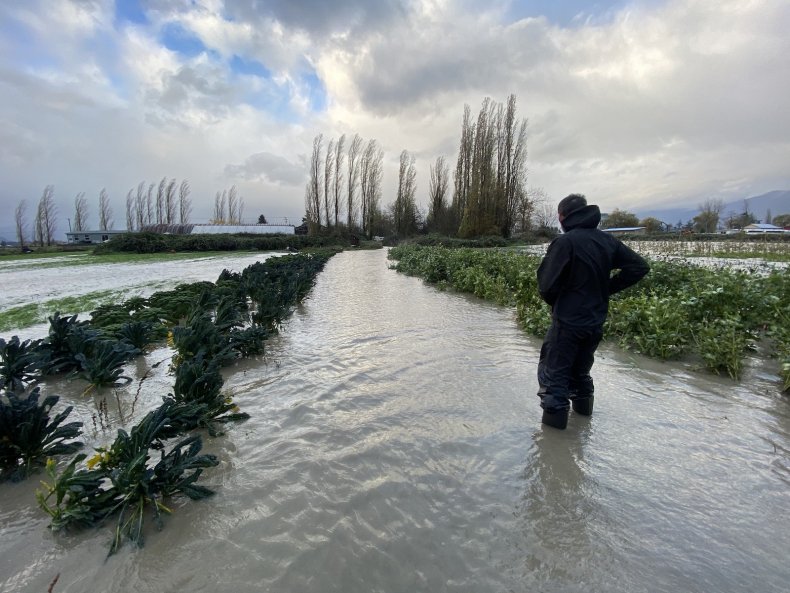When an unprecedented atmospheric river sent floodwaters through Travis Forstbauer’s fields earlier this month, the Chilliwack, BC farmer was worried about losing the precious fertile land on which his livelihood depends. He was pleasantly surprised when the water receded to see that his land had suffered minimal damage.
They were saved by their cover crops, crops like alfalfa or rye grown in the fields during the winter, which kept the soil rooted in place.
“(Approximately) 95 percent of our fields are covered with some type of vegetation. Most of it is cover crops,” he said. “A cover crop is important, it really shows in a flood.”
Unlike many conventional farmers who leave their fields bare when not in use, organic and agroecological farmers like Forstbauer often plant a cover crop to restore their soil with nutrients and organic matter.
It turns out that cover crops and other key practices in organic, regenerative and agroecological agriculture are also helping farms weather the climate crisis. In addition to keeping soils stable during floods, they protect the soil from extreme heat, which can kill important microbial ecosystems and help retain moisture during dry spells.
“These agroecological systems are very effective in adapting to climate change,” said University of Winnipeg geography professor Ian Mauro. “I know many growers who are using these types of systems, and they have been disrupted by recent weather events, but they have been able to buffer them in a fairly consistent and significant way,” he added.
Agroecology is an approach to agriculture that integrates farms into natural ecosystems to prioritize soil health and biodiversity. It also addresses social and economic inequality by prioritizing the autonomy of farmers from large seed and fertilizer companies, the rights of agricultural workers, and the food sovereignty of communities.
What people are reading

The approach is embedded in the agricultural policies of the European Union and other countries and could be included in future global climate agreements. Earlier this year, the federal government created a program that partners farmers and scientists to develop more sustainable agricultural practices. It has also said it will spend $ 270 million by 2023 to help farmers transition to more sustainable and resilient practices, such as cover crops.
However, Canada has generally been reluctant to include agroecology in national and international agricultural and climate policies. For example, at the recent COP26 international climate conference, Canada committed to a pact in support of technology and “climate-smart” solutions favored by the US and large agribusinesses, while blocking efforts by the US. developing countries to include agroecology in the official UN treaty. .
Critics say that governments and companies that eschew agroecology in favor of industrial agricultural practices that increase yields, and the profits of agribusinesses, at the expense of the environment, should take note of the resilience shown by farmers. They have taken the approach.
Cover crops and other key practices in organic, regenerative and agroecological agriculture are also helping farms weather the climate crisis. In addition to keeping soils stable during floods, they protect the soil from extreme heat and capture moisture.

“Climate change adaptation and mitigation became one thing in a holistic integrated system (that is) in balance with the natural world … Not only is it theoretically possible, but many farmers are doing it and it is working,” he said Mauro. “We desperately need that kind of innovation and scaling up to cushion the changes we’re seeing.”
Karen Klassen is one of those farmers. In recent years, he has been replacing conventional practices that rely on pesticides and fertilizers with more sustainable approaches, such as cover crops on his family’s grain and vegetable farm in Manitoba. When months of extreme drought, and a single, intense monsoon in June, hit his farm this summer, fields cultivated with agroecological techniques performed better.
“It basically didn’t rain the entire growing season. It barely snowed to begin with, and we had a big deluge in June, (but) the crops had been planted and it didn’t really help them,” he said. said. “But the fields that we hadn’t cultivated that had things that grew like peas and wheat and early seeds, they did well.”
Driving past other nearby farms, he noticed significant differences in crop health between fields. While this could be due to peculiarities in the landscape that gave the fields more water, he said he would like to see firm data on the link between that resilience and the adoption of more sustainable techniques by farmers.
In addition, the fields he cultivated using more regenerative techniques had the added advantage of not needing expensive artificial fertilizers and could be sold on the more valuable organic market.
Klassen said “unprecedented” high world prices for staples like wheat mean the farm has performed well financially despite the drought. Still, because it’s impossible to predict when prices will drop again, increasing your farm’s resilience to climate chaos is essential.
“Food security, where our food will come from in a changing climate, is something we cannot take for granted. It is something we must plan and invest deeply,” warned Mauro. “When we think about advancing climate resilience, it requires (planning and investing in everything) from soil health and ecosystem well-being and sustainable production methods to the cultural practice of consuming, eating and transporting food.”
At BC, Forstbauser said fostering relationships between people, food and soil will be essential for years to come. This will mean a change of perspective for farmers, consumers and policy makers from a rigid and industrialized approach to one focused on adapting to different landscapes and specific needs of communities.
“We are in a generation where we can get almost anything we want: click the mouse and it will be here. Agriculture is not the same … It is about maintaining the health of the soil, maintaining biodiversity,” he said. “There is a spiritual aspect, whether you are cultivating conventionally or organically. It is whether we choose to acknowledge it.”
Reference-www.nationalobserver.com